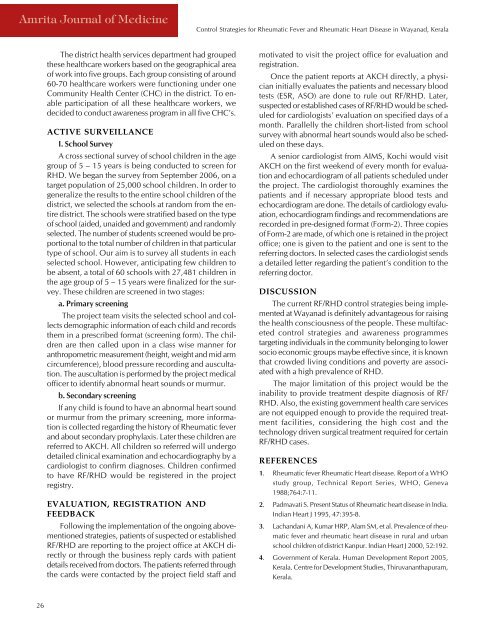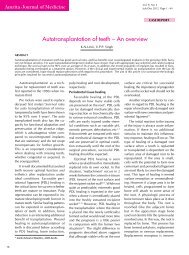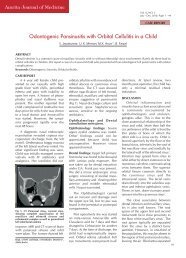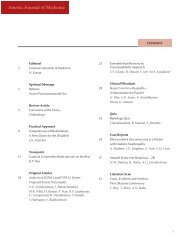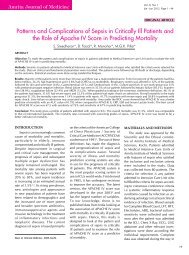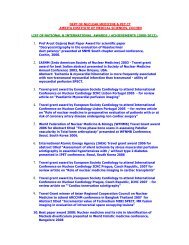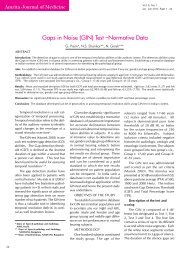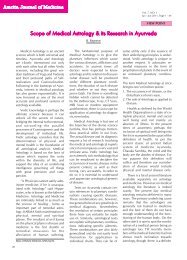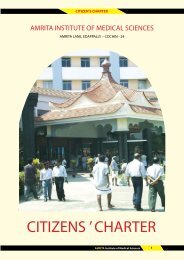Journal of Medicine Vol 2 - Amrita Institute of Medical Sciences and ...
Journal of Medicine Vol 2 - Amrita Institute of Medical Sciences and ...
Journal of Medicine Vol 2 - Amrita Institute of Medical Sciences and ...
You also want an ePaper? Increase the reach of your titles
YUMPU automatically turns print PDFs into web optimized ePapers that Google loves.
<strong>Amrita</strong> <strong>Journal</strong> <strong>of</strong> <strong>Medicine</strong><br />
Control Strategies for Rheumatic Fever <strong>and</strong> Rheumatic Heart Disease in Wayanad, Kerala<br />
The district health services department had grouped<br />
these healthcare workers based on the geographical area<br />
<strong>of</strong> work into five groups. Each group consisting <strong>of</strong> around<br />
60-70 healthcare workers were functioning under one<br />
Community Health Center (CHC) in the district. To enable<br />
participation <strong>of</strong> all these healthcare workers, we<br />
decided to conduct awareness program in all five CHC’s.<br />
ACTIVE SURVEILLANCE<br />
I. School Survey<br />
A cross sectional survey <strong>of</strong> school children in the age<br />
group <strong>of</strong> 5 – 15 years is being conducted to screen for<br />
RHD. We began the survey from September 2006, on a<br />
target population <strong>of</strong> 25,000 school children. In order to<br />
generalize the results to the entire school children <strong>of</strong> the<br />
district, we selected the schools at r<strong>and</strong>om from the entire<br />
district. The schools were stratified based on the type<br />
<strong>of</strong> school (aided, unaided <strong>and</strong> government) <strong>and</strong> r<strong>and</strong>omly<br />
selected. The number <strong>of</strong> students screened would be proportional<br />
to the total number <strong>of</strong> children in that particular<br />
type <strong>of</strong> school. Our aim is to survey all students in each<br />
selected school. However, anticipating few children to<br />
be absent, a total <strong>of</strong> 60 schools with 27,481 children in<br />
the age group <strong>of</strong> 5 – 15 years were finalized for the survey.<br />
These children are screened in two stages:<br />
a. Primary screening<br />
The project team visits the selected school <strong>and</strong> collects<br />
demographic information <strong>of</strong> each child <strong>and</strong> records<br />
them in a prescribed format (screening form). The children<br />
are then called upon in a class wise manner for<br />
anthropometric measurement (height, weight <strong>and</strong> mid arm<br />
circumference), blood pressure recording <strong>and</strong> auscultation.<br />
The auscultation is performed by the project medical<br />
<strong>of</strong>ficer to identify abnormal heart sounds or murmur.<br />
b. Secondary screening<br />
If any child is found to have an abnormal heart sound<br />
or murmur from the primary screening, more information<br />
is collected regarding the history <strong>of</strong> Rheumatic fever<br />
<strong>and</strong> about secondary prophylaxis. Later these children are<br />
referred to AKCH. All children so referred will undergo<br />
detailed clinical examination <strong>and</strong> echocardiography by a<br />
cardiologist to confirm diagnoses. Children confirmed<br />
to have RF/RHD would be registered in the project<br />
registry.<br />
EVALUATION, REGISTRATION AND<br />
FEEDBACK<br />
Following the implementation <strong>of</strong> the ongoing abovementioned<br />
strategies, patients <strong>of</strong> suspected or established<br />
RF/RHD are reporting to the project <strong>of</strong>fice at AKCH directly<br />
or through the business reply cards with patient<br />
details received from doctors. The patients referred through<br />
the cards were contacted by the project field staff <strong>and</strong><br />
motivated to visit the project <strong>of</strong>fice for evaluation <strong>and</strong><br />
registration.<br />
Once the patient reports at AKCH directly, a physician<br />
initially evaluates the patients <strong>and</strong> necessary blood<br />
tests (ESR, ASO) are done to rule out RF/RHD. Later,<br />
suspected or established cases <strong>of</strong> RF/RHD would be scheduled<br />
for cardiologists’ evaluation on specified days <strong>of</strong> a<br />
month. Parallelly the children short-listed from school<br />
survey with abnormal heart sounds would also be scheduled<br />
on these days.<br />
A senior cardiologist from AIMS, Kochi would visit<br />
AKCH on the first weekend <strong>of</strong> every month for evaluation<br />
<strong>and</strong> echocardiogram <strong>of</strong> all patients scheduled under<br />
the project. The cardiologist thoroughly examines the<br />
patients <strong>and</strong> if necessary appropriate blood tests <strong>and</strong><br />
echocardiogram are done. The details <strong>of</strong> cardiology evaluation,<br />
echocardiogram findings <strong>and</strong> recommendations are<br />
recorded in pre-designed format (Form-2). Three copies<br />
<strong>of</strong> Form-2 are made, <strong>of</strong> which one is retained in the project<br />
<strong>of</strong>fice; one is given to the patient <strong>and</strong> one is sent to the<br />
referring doctors. In selected cases the cardiologist sends<br />
a detailed letter regarding the patient’s condition to the<br />
referring doctor.<br />
DISCUSSION<br />
The current RF/RHD control strategies being implemented<br />
at Wayanad is definitely advantageous for raising<br />
the health consciousness <strong>of</strong> the people. These multifaceted<br />
control strategies <strong>and</strong> awareness programmes<br />
targeting individuals in the community belonging to lower<br />
socio economic groups maybe effective since, it is known<br />
that crowded living conditions <strong>and</strong> poverty are associated<br />
with a high prevalence <strong>of</strong> RHD.<br />
The major limitation <strong>of</strong> this project would be the<br />
inability to provide treatment despite diagnosis <strong>of</strong> RF/<br />
RHD. Also, the existing government health care services<br />
are not equipped enough to provide the required treatment<br />
facilities, considering the high cost <strong>and</strong> the<br />
technology driven surgical treatment required for certain<br />
RF/RHD cases.<br />
REFERENCES<br />
1. Rheumatic fever Rheumatic Heart disease. Report <strong>of</strong> a WHO<br />
study group, Technical Report Series, WHO, Geneva<br />
1988;764:7-11.<br />
2. Padmavati S. Present Status <strong>of</strong> Rheumatic heart disease in India.<br />
Indian Heart J 1995, 47:395-8.<br />
3. Lach<strong>and</strong>ani A, Kumar HRP, Alam SM, et al. Prevalence <strong>of</strong> rheumatic<br />
fever <strong>and</strong> rheumatic heart disease in rural <strong>and</strong> urban<br />
school children <strong>of</strong> district Kanpur. Indian Heart J 2000, 52:192.<br />
4. Government <strong>of</strong> Kerala. Human Development Report 2005,<br />
Kerala. Centre for Development Studies, Thiruvananthapuram,<br />
Kerala.<br />
26


